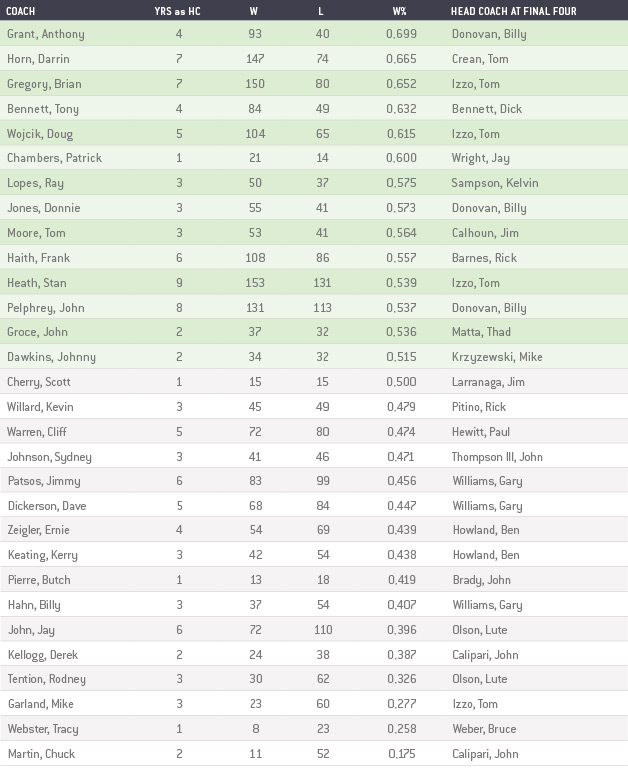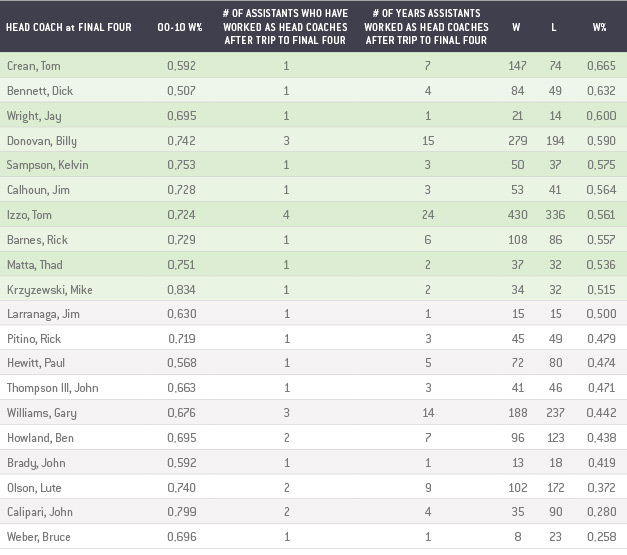When an assistant coach becomes a head coach, does he win more if he comes from a successful program? 1 To consider this question, we analyzed the complete staffs of coaches who have reached the Final Four in the last decade and the subsequent success of their assistants who went on to obtain head coaching positions. Between 2000 and 2010, 28 head coaches led their teams to a Final Four bert. 2 A total of 248 coaches spent at least one year as an assistant on the staffs of these select head coaches in their careers. 3 Of the 248 assistants, 137 obtained head coaching positions.
Surprisingly, the average subsequent winning percentage (W%) in the head coach position of these former assistants is .506 compared to a .473 average head W% for promoted assistants without experience working with a Final Four coach. Although there is a slight difference between these two groups, the fact that the higher achieving coaches are just over .500 as a group frames how much more “successful” they are than the second group. This means assistants from successful programs should not be expected – based on the past 10 years – to produce a significant number of wins or a high W%. 4
The following table reflects coaches who went to the Final Four (2000-2010) as an assistant and subsequently went on to head coaching jobs themselves.
FIGURE 1: Winning Percentages of Head Coaches Who Made the Final Four as Assistant Coaches

Among these select coaches in Figure 1, while their average W% as a group is .487, there are 13 coaches (Grant to Dawkins) who each outperformed that benchmark (see green highlight: .515 for Dawkins all the way up to .699 for Grant).
This group of 13 coaches might suggest that certain coaching trees do a better job of preparing future head coaches to reach the Final Four. Yet when we break down the Final Four head coaches they worked with prior to becoming a head coach (see below, Figure 2) 5, the data do not demonstrate any pattern between appearances at the Final Four and more successful future head coaches, measured by W%.
FIGURE 2: Final Four Head Coaches and their Assistants – comparison of Winning Percentages

Let’s also be pragmatic about the framing of our research question and what we found: Irrespective of coaching tree relationships and Final Four appearances, the coaches highlighted in green in Figures 1 and 2 are most certainly top performers and merit careful review by decision makers for the total picture of their individual successes and compensation structures relative to performance.
For a descriptive view of the relationships between these selected Final Four coaches, Professor Dan Halgin compiled a visual representation of the interconnections of the coaching staffs of the 28 Final Four coaches during the past decade (see next page, Figure 3). As in the diagram, some of the Final Four head coaches were once assistants to other Final Four head coaches (e.g., Donovan once worked for Pitino, Pitino once worked for Boeheim) and some assistants have served on the staffs of more than one of the selected Final Four Head Coaches. These connections create the “small-world” phenomenon in the NCAA coaching profession. Notably, there are 95 total coaches linked across a chain connecting the staffs of Stevens, Matta, Weber, Self, Sutton, Donovan, Barnes, Pitino, Boeheim, Huggins and Gary Williams.
If we analyze the network connecting all active 2010 coaches (there are 1369 active head and assistant coaches in Division I) we can identify coaches who occupy interesting positions in the network. Piecing the coaching world together in this way, here are three highlights in closing
1. Robert McCullum of the University of Central Florida, has worked with the most number of other active coaches (22 others).
2. Herb Sendek of Arizona State University is the most “popular” – he has worked with multiple coaches who themselves have worked with multiple coaches.
3. Jim Christian of Texas Christian University, is the “Kevin Bacon” of the coaching world. You can link Christian to any other active coach in an average of 3.5 steps (e.g., Christian is connected to John Calipari in three steps. Christian worked with Glynn Cyprien who worked with Josh Pastner who worked with Calipari).
FIGURE 3: Historical staff connections of the 2000-2010 Final Four head coaches

References:
- For our purposes, we measure “success” as a program that has reached the Final Four. Granted, that’s a narrow definition in some respects (e.g., Elite Eight as the measure would encompass a larger population of leading coaches: Pastner and Barbee, for instance, from the Calipari coaching tree are outside the scope of this research), but the Final Four benchmark it enables a precise analytical review and more concise write up. ↩
- We note that some of these 28 head coaches led multiple teams to the Final Four in the 2000 to 2010 time period. ↩
- “Careers” is an important descriptor. In this study, bear in mind that while the W-L records are from 2000 on, the actual relationships pre-date 2000 in many cases. Since we could not control for this variable in the analysis, we note “careers” as a qualifier in our findings. ↩
- The data underlying the foregoing observations does not control for the relative position of teams when a new head coach takes over. It could be that the progeny of some Final Four coaches take on more challenging assignments as first-time head coaches (e.g., Coach Grant, who is performing very well in what was arguably a challenging new role at Alabama, as we show below). Those situations are not contemplated in the scope of our analysis, mostly because it means a longer write up, plus some retrospective measurements that could reduce objectivity in the results. ↩
- Like Figure 1, we highlight coaches (in green) in Figure 2 outperformed the .506 W% benchmark. ↩



